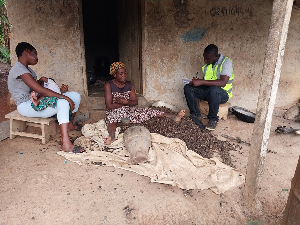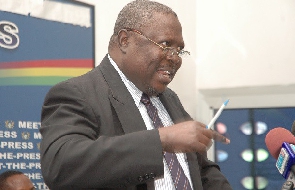Ten years ago, I became a sustainability officer for one of the cocoa companies in Ghana.
Together with other full-time officers, we provided farmers with training on cocoa production each year. In my cocoa journey, I worked with other cocoa companies too. Two years ago, I became the executive director of Imperial Child Rights and Women Empowerment. We have few resources, but a lot of heart.
Last month, as I was collecting data in one of the communities, a young girl with a baby approached and greeted me, “Officer!” I responded, “Hey, how are you?” “I’m Doris,” she said. “Do you remember me? My mom was part of your farming program when I was a kid.”
At this point, I did remember her. She was a smart, energetic teen in upper primary school just six years ago, full of hope for her future. Now, she was a mom herself. She’d dropped out of junior high school. I was horrified.
Doris was the face of intergenerational poverty, but she wasn’t supposed to be. Cocoa companies and stakeholders aim to help families achieve self-sufficiency, not just share cutlasses, school accessories, and premiums during tough times. We had helped Doris and her family once.
She was supposed to grow up, finish school, continue to senior high school, and
live a happy, stable life. She did not make it. And that’s when I realized we were getting it all wrong.
This should worry us because the stresses of growing up as a child labourer permanently alter the wiring in the brains of these children.
Now, think of Doris again, and multiply Doris by 2 million, because right now, we’re failing the 2 million children working as child labourers in West Africa today, primarily Ghana and Ivory Coast, including around 800,000 child labourers right here in Ghana. That’s enough children to fill our stadium ten times. What I realized that day is that Doris is not a failure; we are.
We spend millions of dollars each year on eradicating the worst form of child labor, and yet the rate of child labour and its worst forms continues to increase. I believe there are three main ways we’re getting things wrong.
First, we have relegated poverty and child labour eradication to the realm of the heart, to the charities and organisations. Heart is absolutely essential, but my grumble with leaving poverty and worst forms of child labour there is that, it is unconcerned about the seriousness and the intricacies of the problem we are trying to solve. No matter how many school bags, books, cutlasses, premiums, etc we provide; we will not eradicate child labour without our brains as well.
Too often, we focus on eradicating child labour without addressing the issues that create it.
It is like responding to the diabetes epidemic by setting up more clinics for the blind. Also, we need to stop placing the burden of eradicating child labour on the children and parents experiencing it and start breaking down the crushing systems that keep the children there.
Like when we try to help farming communities and kids by achieving “self-sufficiency,” when in fact what we have is a structural problem. Let us think of a way to structure it so that parents who are working full-time or more earn enough to support their families.
These two errors in our approach stem from a flaw in our belief. Child labour and its worst forms will not always be with us. It is not the norm throughout the developed world. We can end it.
That day, after meeting Doris, I went back to the drawing board and began to think about what we could do to actually solve child labour and its worst forms. We are just one non-profit in one small corner of the country, but I pledged that day to do better and to work with the farming communities to identify and overcome the impossible barriers that they are up against.
Since we can’t just take all the children in our farming communities and move them to more affluent communities, our goal is to impact the place in which they live. We aim to reach at least 60 percent of the families with young children in the communities.
Think about how change happens. We are social creatures urged towards progress by our social networks.
So, right now, we have shifted our efforts toward empowering one entire community, and rather than helping families here or there, our goal is to transform the entire community.
Rather than merely providing direct services, we aim to build equity in our communities. We have begun by going door-to-door to ask members of the community how they saw their community and to find out what help, if any, they needed. Because when you reach out to members of the community and invite them to be a part of the process, it stops being about doing things for people and becomes about doing things with people.
This is because it’s a small-scale approach to ending systemic child labour and its worst forms. If we continue on this trajectory, I am confident we will make a lasting change in the communities.
But we need to solve child labour and its worst forms nationally, and we can. We can do this the way we have achieved other historic accomplishments. When we set out to cure polio or put a man on the moon, we started by setting a daring goal, committing to a long process of trial and error, dedicating resources and research to the problem, and utilizing our experts.
We can do this again for this problem. We must pledge that we will not allow this cycle to continue, not in the biggest economy the world has ever known. We all have a role to play, not just non-profits and stakeholders, but businesses and the government too.
Child labour and its worst forms are a complicated problem with a complicated history, impacted by complicated systems, and so it’s easy to get overwhelmed and just go back to doing what we’ve always done, or worse yet, do nothing at all. Let’s acknowledge these tough truths and move forward.
Let’s stop blaming Doris for being a child labourer, for growing up poor, and for ending up poor, as though it’s somehow her fault.
Instead, let’s look at the systemic substructures of unfairness that propagate cycles of child labour and its worst forms. Let’s commit our hearts and our heads to solving this together, not just sharing items and premiums with the farmers. And let’s invite the experts to the table—in this case, members of the communities that are impacted. We set out as one small non-profit to end child labour and its worst forms in our farming communities.
Let’s commit our vast resources to creating a tipping point together so that we can stop treating the symptoms of child labour and its worst forms and end it once and for all.
Opinions of Friday, 2 August 2024
Columnist: Bright Debrah Adjei



















